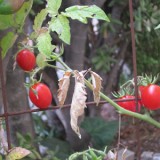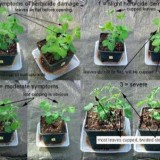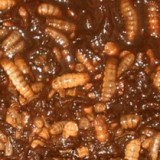Here’s an unintended organic gardening chain of events:
1. Scoop up multiple trash bags full of fruit scraps from Fallen Fruit’s jam making event at Machine Project.
2. Add this large bounty of organic material to the compost pile.
3. Watch as a bunch of beetle larvae hatch and devour the fruit and other goodies in the compost pile.
4. Sift compost and feed most of the larvae to a happy flock of hens.
5. Add compost to the vegetable garden.
6. Plant seedlings.
7. Wake up the next morning to find out that skunks have spent the night rampaging through the vegetable beds in search of the remaining grubs. Yell in frustration at the sight of all the uprooted seedlings that took a month to grow in flats.
Now I knew that skunks were a problem at our place, and I had covered the beds each night with some spare shade cloth to keep them out. But on this particular evening I had forgotten to cover the beds. Pepé le Peu had destroyed a month’s worth of work.
Setting about to find a solution, I considered everything from high powered weapons to peeing off the front porch to spreading batches of compost for the hens to pick through. Not wanting a visit from the LAPD, I settled on floating row covers, a light fabric that is used to exclude pests and protect plants from frost. Row covers would also take care of another persistent problem, cabbage worms. But here in USDA zone 10, where we have only occasional frosts, row covers have the potential to make growing conditions too warm. Thankfully I was able to get a roll of an extremely light row cover material called Agribon 15. Agribon makes a range of row covers in varying thicknesses. Agribon 15 is the lightest and is used mainly to exclude pesky insects. It has also worked with the skunks, who seem unwilling to poke through the flimsy fabric. Those of you in colder places should use a heavier cover to retain more heat.

I drilled holes in the corners of the beds and bent some scrap PVC pipe to create hoops to hold the row cloth above the plants. Agribon is so light that you can just put it on top of many plants without hoops.

Now I can sleep at night knowing that my beds are locked down in a kind of “vegetable Guantanamo”.

Johnny’s Seeds sells Agribon 15 in 250 foot rolls for $45. Seeds of Change sells it in 5o foot lengths for $26. It would make sense for most urban homesteaders go in with a few friends on a roll.
Watch a video on how to install row covers at Johnny’s Seeds.






Bummer. I, too, have learned the hard way. Now I make a little fence out of stakes and chicken wire and put it around the bed. Skunks are not climbers, so 18″ works fine. I just leave these up until the plants are well-established. You can drape shade cloth or row covers over the top if you want, but this way you don’t have to put it on and off every day.
I’m just back from Thanksgiving away from home….sorry about your loss.
I have both skunks and raccoons to contend with and I’m not sure what I’m going to do about the raccoons.